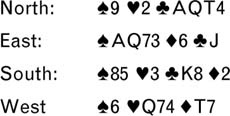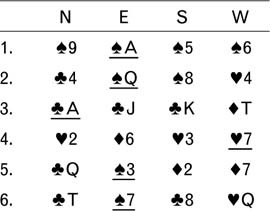The Penguin Book of Card Games: Everything You Need to Know to Play Over 250 Games (58 page)
Read The Penguin Book of Card Games: Everything You Need to Know to Play Over 250 Games Online
Authors: David Parlett

alehouses and ‘below stairs’ (in servants’ quarters), as wel as
‘below decks’ in the British navy. Its great mark of distinction is
having bequeathed us the proper name ‘Jack’ for the card
previously known as ‘Knave’. In Great Expectations, Dickens has Pip
betray his social status in Estel a’s snooty complaint, ‘He cal s the
knaves Jacks, this boy!’
Al Fours underwent its greatest expansion in the United States,
becoming the foremost card game by the beginning of the
nineteenth century. Subsequently chal enged by Poker and Euchre,
it responded not by disappearing but by developing novel
it responded not by disappearing but by developing novel
elaborations to compete with them for interest.
The modern British descendant of Al Fours is an equal y lively
folk-game cal ed Don. Its relations with mid-nineteenth-century
American games are unclear.
Al Fours (Seven Up)
2-4 players, 52 cards
All Fours is a game very much play’d in Kent… and I have known Kentish
Gentlemen and others of very considerable note, who have play’d great sums of
money at It
Charles Cotton, The Compleat Gamester (1674)
We have played together,
Many atime and oft, at Put and Crib,
And at All-Fours have cheated with the best.
‘Captain Crawley’ (G. F. Pardon), The Card-Player’s Manual (1876)
An old English game of possible Dutch origin, All Fours has been so long played
in England and in former Caribbean slave states as to have given rise to many
variants and derivative games, notably Don (p. 186). r further details and an
account of the modern Trinidadian game, e
Preliminaries From two to four play, four either cut-throat or in
fixed partnerships.
Deal From a 52-card pack deal six cards each in threes, and turn the
next as a prospective trump. If it’s a Jack, dealer scores 1 point.
Object To win as many as possible of the four points for high
(playing the highest trump), low (winning the trick containing the
lowest trump in play), Jack (winning a trick with or containing †
J), and game (winning the greatest value of cards in tricks).
Cards The rank of cards in descending order, and the value they
count towards the point for ‘game’ when taken in tricks, is:
A K Q J 10 98765432
4 3 2 1 10 0each
The total value of cards in the pack is therefore 80, but not al of
them are likely to be in play.
Choosing trumps Eldest may accept the turn-up as trumps by saying
‘(I) stand’, in which case play begins, or refuse it by saying ‘Beg’. If
he begs, dealer may accept by saying ‘(I) give you one’, in which
case eldest scores 1 point and play begins, or ‘Refuse the gift’, in
which case the turn-up is turned down and the cards are ‘run’.
Running the cards If the first turn-up is turned down, three more
cards are dealt to each player and the next is turned up. If it is the
same suit as before, the cards are run again, and so on until a
dif erent suit appears. When a new suit appears, it is automatical y
entrumped and, if it is a Jack, the dealer scores 1 point. If none
appears before the cards run out, the hands are thrown in and the
same dealer deals again.
Discard If the cards were run, everyone reduces their hand to six by
discarding the extras face down before play begins. (Variant: This is
usual y ignored if the first run produced a new trump, so there are
nine tricks instead of six.)
Play Eldest leads first. Players may freely fol ow suit or trump, but
may renounce only if unable to fol ow suit. The trick is taken by
may renounce only if unable to fol ow suit. The trick is taken by
the highest card of the suit led, or by the highest trump if any are
played, and the winner of each trick leads to the next.
Score Up to 6 points may be scored in al : 1 for ‘gift’, 1 for turning
a Jack, if applicable, and thereafter 1 each for high, low, Jack, and
game. If two or more players or sides tie for ‘game’, by taking the
same number of card-points, that point is not scored.
Game Play up to 7 points. If tied, the winner is the first to reach 7
as the result of counting high, low, Jack, game, in that order of
priority.
Revoke If a player renounces when able to fol ow suit, he may not
score for Jack or game, and each opponent scores 1 point, or 2 if
the Jack is in play.
Al Fives
(2p, 52c) As Al Fours, but with additional scoring features. Upon
winning a trick with or containing the trump Ace, a player
immediately scores 4 points, the King 3, Queen 2, Jack 1, Ten 10,
Five 5. Add 1 point each for high, low, Jack, and the game. In
assessing the point for game, the trump Five counts 5, and al Aces,
Kings, Queens, Jacks and Tens count respectively 4, 3, 2, 1, and 10
each. Game is 61 up, and is best scored on a cribbage board.
California Jack
(2p, 52c) Deal six each in threes and stack the rest, face up. The suit
of the top card is trump for the whole of the deal. Non-dealer leads.
Second to a trick must fol ow suit if he can, otherwise may play
anything. The winner of a trick draws the top card of stock; the
loser draws the next. When the stock is finished the last six tricks
are played out as usual. At the end of play either player scores 1
are played out as usual. At the end of play either player scores 1
point for high, low, Jack and the game. Game is 10 up.
Shasta Sam
(2p, 52c) As California Jack, but with the stock set face down
instead of up. This removes the desirable feature of playing to win
or cede the top card of stock, which, in California Jack, is the best
part of the game.
Troeven (‘Trump’)
(4pp, 32c) This simple partnership game, played in southern
Limburg, reinforces my suspicion of a Dutch origin for Al Fours.
Virtual y identical is Couil on, or Couyon, played in Normandy on a
tournament basis.
Deal a batch of four cards each from a 32-card pack ranking and
counting as fol ows: Ace 4, King 3, Queen 2, Jack 1, T-9-8-7 zero,
total 40 card-points. Eldest announces trumps on the basis of the
first four cards, then the rest are dealt out in fours. Eldest leads to
the first of eight tricks. Players may freely fol ow suit or play a
trump, but may renounce only if unable to fol ow suit. The trick is
taken by the highest card of the suit led, or by the highest trump if
any are played, and the winner of each trick leads to the next. If the
trump-makers take more card-points, they score 1 game point. If
not, they lose 1 game point and their opponents score 1 plus. If
tied, the game point is held in abeyance and goes to the winners of
the next deal. Play up to 7 game points. (There are versions for two
or three players.) [Troeven from: Harry Tiggelovend, The Playing
Card (XXIV, 6); Couil on from Daynes, Le Livre de la Belote (Paris
1996).]
Pitch(Auction Pitch, Setback)
2-7 players (4 best), 52 cards
Pitch is a variety of Al Fours characterized by the fact that, instead
of turning a card for trump, that suit is fixed by whoever bids to
win a minimum number of the points available. Furthermore, the
trump suit is not announced verbal y, but is indicated by ‘pitching’
– that is, leading a card of that suit to the first trick.
Preliminaries From two to seven play with a 52-card pack ranking
AKQJT98765432.
Deal Deal six each in batches of three and stack the rest, face down,
out of play.
Object Up to four points are played for in each deal, one each for
high, low, Jack and game (see Al Fours).
Bidding Each in turn bids to win from 1 to 4 of the points available,
without naming a trump (yet). Each bid must be higher than the
last. No one may bid more than once.
Dealer’s right An optional but common rule permits the dealer to
take the previous bid over at the same level. For example, if the
bidding goes ‘one’, ‘two’, ‘three’, the dealer may also bid ‘three’. But
if the first three pass, dealer is obliged to bid at least one.
Play The highest bidder declares trumps by ‘pitching’ one of them
as the lead to the first trick. Players may freely fol ow suit or trump,
but may renounce only if unable to fol ow suit. The trick is taken
by the highest card of the suit led, or by the highest trump if any
are played, and the winner of each trick leads to the next.

Score The points for high, low, Jack, and the game go to whoever
earns each of them, except that there is no point for game if two
players tie for counters. If the pitcher fails to make what he bid, he
is set back by the amount of his bid, which can result in a minus
score.
Game The game is won by the first player or side to reach an
agreed target (e.g. 7, 11, or 21 points, depending on the number of
optional scoring features included). If two players reach the target
in the same deal, the pitcher wins; or, if neither is the pitcher, the
winner is the one who reached it first, counting strictly in order the
points for high, low, Jack, and the game. Anyone with zero or a
minus score pays a double stake.
Sample deal
North bids two, hoping to win for ‘high’ and ‘game’. East bids three
for the same reasons plus the hope of either winning ‘low’ with his
Three or, more desperately, catching the Jack if it is in play. South
and West pass. East pitches the Ace, making spades trump.


